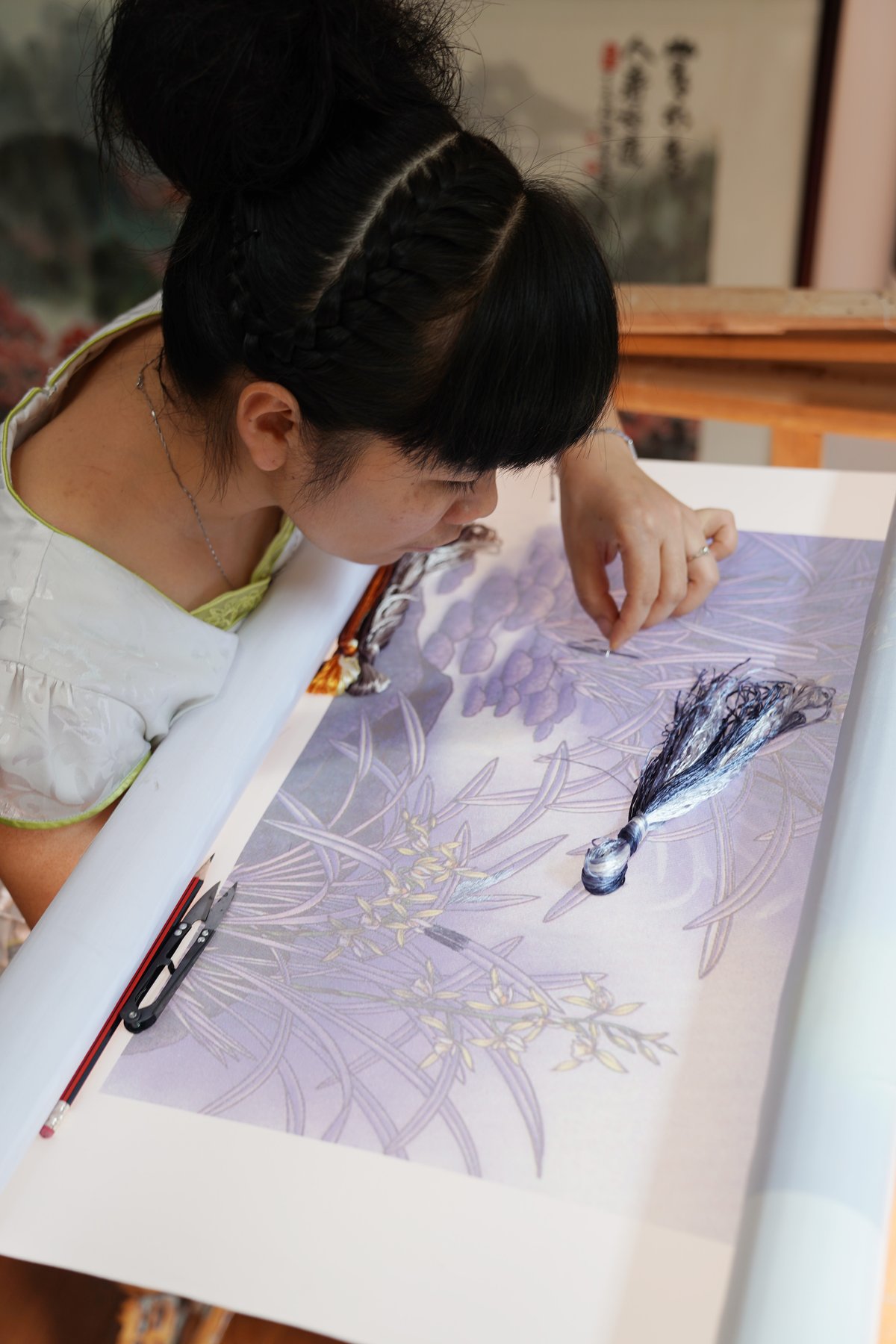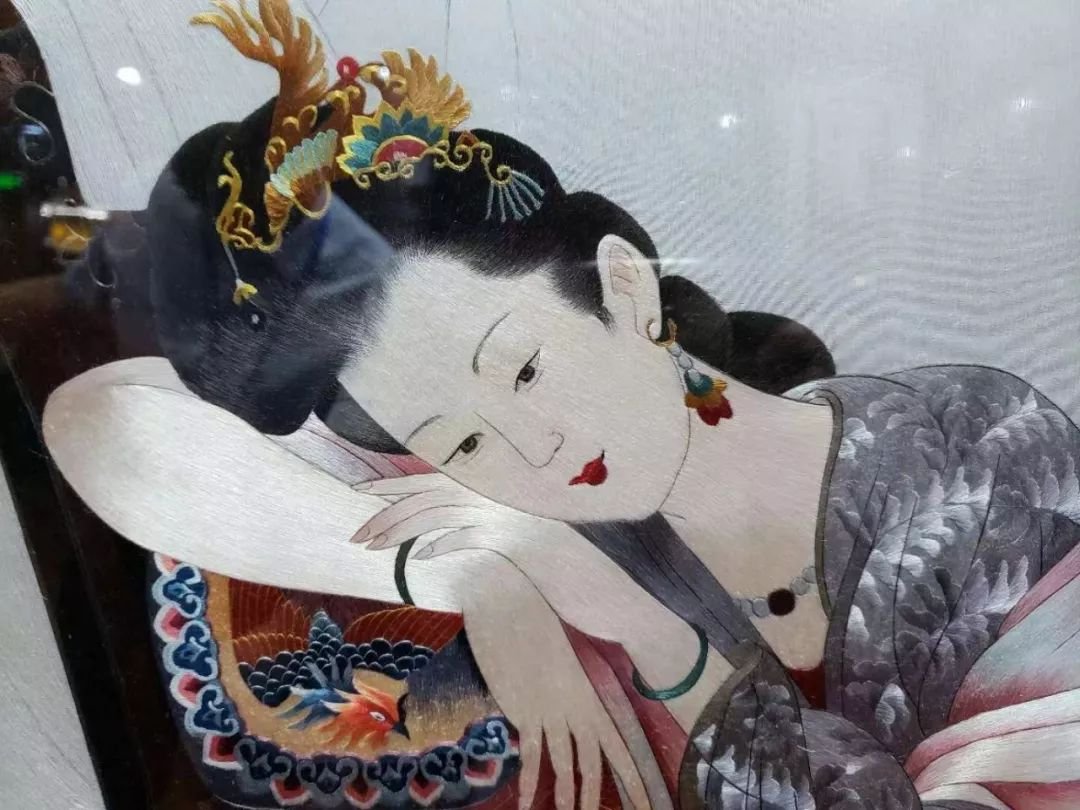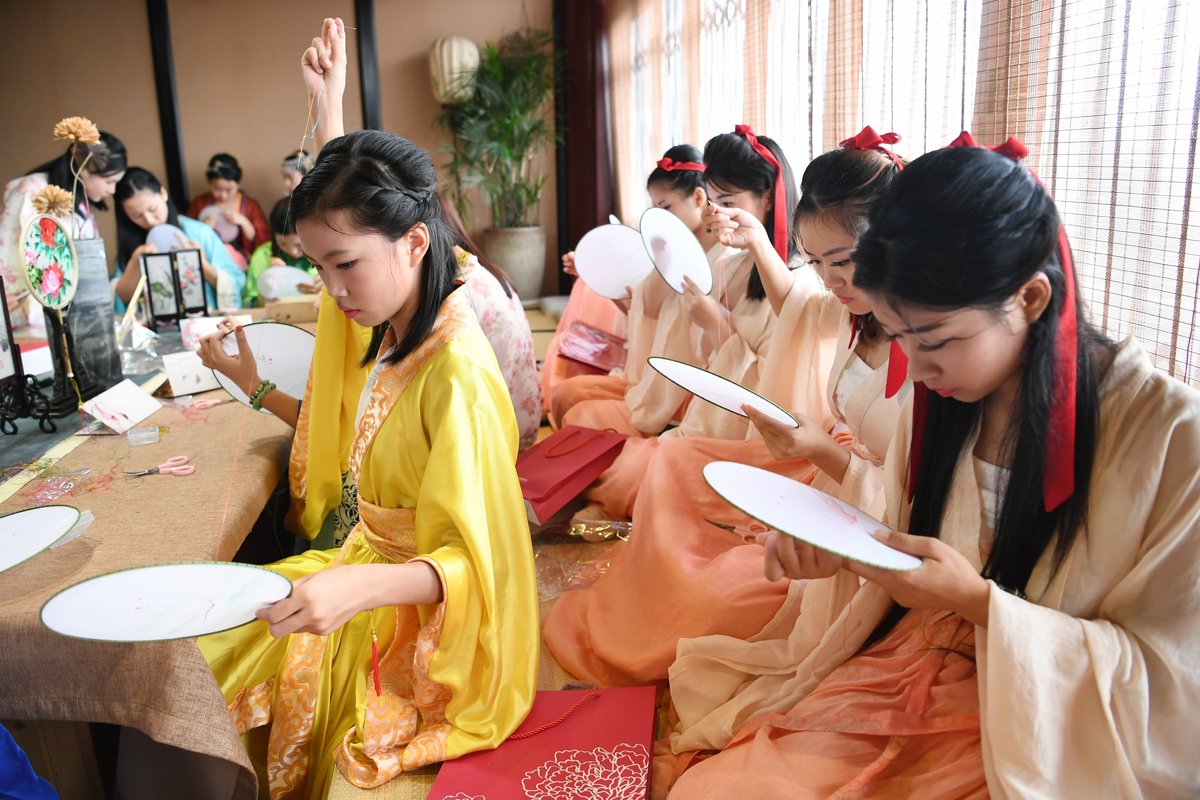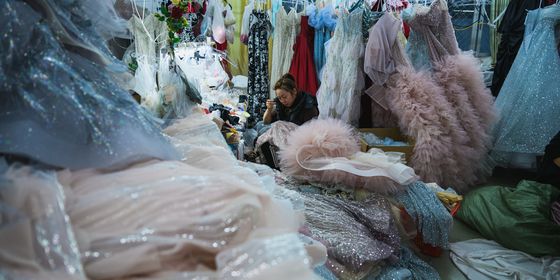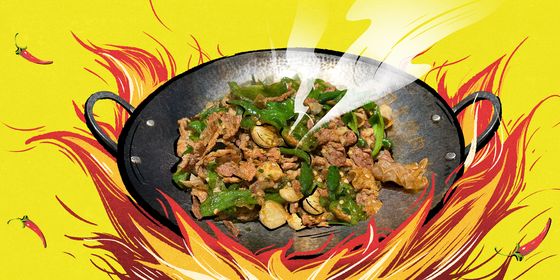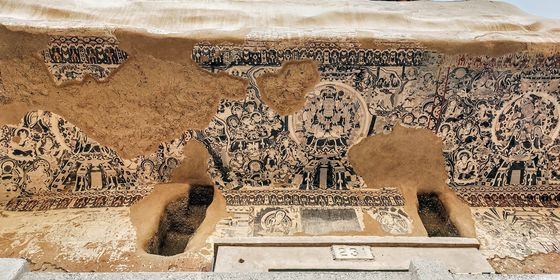A practitioner of a traditional, formerly all-female art of Xiang embroidery recounts her rigorous training and extraordinary life
Part of my job requires that I purchase gifts for foreign clients of my company. I often choose Xiang embroidery from Hunan province, so I am now on fairly familiar terms with the boss of the embroidery “village” I visit. One day, I arrived with a client who wanted to watch the embroidery process with his own eyes. The boss took us both to the studio of one of the embroidery artisans, Madam Rui.
Madam Rui is turning 40 this year, and she is regarded as an "old hand" in Jinxia City, a hub for traditional embroidery in Changsha. When we arrived at the studio, Madam Rui was instructing her apprentices on the “split line” technique; she then turned around and warned one of her students to watch the tension frame. When Madam Rui saw us coming, she put down her work so that she could show her visitors around. Within that small room, a thousand threads emanated from the swift needles of this army of embroiderers, who painted vivid portraits of landscapes, flora and fauna, and human figures as easily as if using pen and ink.
Madam Rui took to me after a few visits, and we often made small talk. Eventually, I took a personal interest in embroidery, and wanted to try my hand at a few floral patterns under her guidance. Madam Rui suddenly became serious. "Embroidery is not a hobby. You need to start your apprenticeship in your teenage years.”
I had to give up my dream, but I was still curious about her story, so I invited her to a cup of tea one afternoon in order to talk. I listened to the ups and downs of a life that these embroiderers created with their own hands. This is Madam Rui’s story:
1/8
Madam Rui is not my real name.
I was born in a remote town in western Hunan province, the youngest of four daughters. My mother never gave birth to a boy that could inherit the family’s name, so my sisters and I inevitably came to have the character for "brother (弟)" in our names, paired with another character that reflected my parents’ deep desire for an heir—anticipating (盼), beckoning (招), thinking of (想), and hoping (望).
However, after I was born, my mother's belly never bulged again. This preference for a son over daughters was not something my young self ever really understood. All I knew was that my father never cared about household matters, and when it came to money matters, my mother had to tread carefully. When my sisters and I reached school-age, our household expenses increased. My eldest sister married young, and my second sister dropped out of school to work. I saw a helpless and desperate look in my mother’s eyes, and knew that my third sister’s and my own schooldays were nearing their end.
Nine-year compulsory education was not yet universal in the most remote areas of western Hunan back in 1990. I was 12 years old and had barely spent five of them in elementary school. At that age, many girls in my region dropped out of school to take up factory or farm work and start supporting their families. My mother was a farsighted woman for her time, and had hoped her girls would get as much education as possible, but her frequent fights with my father over this matter gradually wore her down.
Finally, my father got drunk one day. Smoking his cigarette, he looked at his “freeloaders,” as he called us girls, and said in a muffled voice, "No more school after this semester."
***
That year, a distinguished guest visited our town, though it would be more accurate to describe her as a prodigal daughter who’d returned. This woman was an embroidery artisan who had amassed a certain degree of fame in Changsha. Rumor had it that many of her works had been sold in Hong Kong. Everyone called her "Master Du."
Master Du had run away from an arranged marriage in her hometown when she was still a girl, and she stayed away for many years until she had made a lot of money. By the time she returned, her family had long lost their power to force her into anything.
Thus, her visit was considered a "homecoming". Master Du brought with her enough funds to repair her ancestral house and set up new tombstones for the deceased elders, in observance of traditional customs. All in all, her stay extended for half a month. When the time came to leave again, Master Du enlisted elderly women in the village to spread the word among families with school-age daughters that she would be choosing a few apprentices to take back to Changsha, where they would learn embroidery and eventually become artisans.
Eventually, the news reached my home and I was tempted. After all, if I had to drop out of school and get a job, I might as well just go to Changsha. I’d spent my whole life in this town and had never seen the outside world. I’d learned the so-called feminine arts from my mother, and excelled at sewing and mending, but of course I had no idea whether that would grant me Master Du’s favor. I quietly voiced my thoughts to my mother, and she mulled them over all night long. The next morning at dawn, she agreed I could go.
On the day of the apprentice selection, both my mother and I deliberately wore our best clothes, usually reserved for festivals or weddings. Mother also carried a cloth bag full of farm products, such as whole grains and eggs, and a pair of insoles she’d made herself. We arrived at the door of Master Du’s house before sunrise, only to find 20 other girls standing in the yard, also garbed in their most presentable clothes.
Master Du’s search for apprentices even attracted Yanyan, a physically handicapped girl in town who had been abandoned by the stone bridge when she was still a baby. Her adoptive mother, Aunt Liu, was deaf and mute, and had lived on her own for many years. She ran a food stall, and she was admired for her cooking skills as well as her character.
Though it wasn’t easy for her to make a living, Aunt Liu never denied breakfast to a customer who couldn’t pay. She had found little Yanyan on a day when she was setting up shop, wrapped in a silk cloth embroidered with a swallow, which inspired the child’s name. She told people by gestures that the gods had sent Yanyan to her, a widow with no children, to keep her company. Thus, Aunt Liu ran her breakfast stall and raised Yanyan. The little girl suffered from polio as a young child, so her legs were crippled and she was bound to a wheelchair all year round.
Sometimes Father was in a good mood and threw us some change to buy dough-sticks from Aunt Liu as a small treat, which was how Yanyan and I made each other’s acquaintance. In spite of her disability, she never failed to accompany Aunt Liu to the stall, come rain or come shine. Mother and daughter communicated with each other through their own silent language, using looks and gestures.
Yanyan had obviously thought being an embroidery artisan suited her, and so there she was, ready for her chance.
2/8
Master Du came out, wearing her hair braided behind her back and an immaculate white gown made of a mysterious material. Her clothes were embroidered with small blue and yellow flowers, and her frame was slender.
The official selection hadn’t even started and Master Du had already dismissed half of the contestants with a wave of her hand—they were either too old or else did not look very lingfan, the Changsha word for “clever.” They were left to stand aside and watch from a distance.
Master Du ‘s first command to all the young contestants was to thread the needles. I took up my tools and quickly realized that I was holding no ordinary needle: It had an extremely small eyelet. The thread must have been a special kind. It looked thin and was limp on my hand, something I had never seen before.
Some of the girls next to me were already giving up, but I settled my mind and quieted my hands. I threaded the needle, tied a knot, and waited for Master Du was to check my work.
As it turned out, this stage of the selection was meant to measure our temperament and the stability of our hands. The more a girl would let anxiety affect her, the more difficult would be her task. Half of the girls were wiped out in the blink of an eye.
Our eyesight and observation skills were tested next. Master Du pasted on the glass window a very delicate paper cutting with the Chinese character for happiness, 福, upside down, and an intricate decorative pattern. The rest of us girls stood a few meters away. A soft smile lingered on Master Du’s face, but her words made us break in a sweat again. "In order to pass this test, you must accurately count the number of snowflakes in this paper cutting."
There were six snowflakes surrounding the Chinese character on the paper. Additional snowflakes dotted the inner components of the character—more specifically, the dot on the upper-left side of the character and the inner part of the radical 田 on the lower-right side were all made up of snowflakes. Those were certainly easy to overlook if you weren’t careful. The girls all narrowed their eyes and counted with their fingers. Once they had finished counting, they were to write their final answer on a piece of paper and hand it over to Master Du.
At the end of the test, Master Du eliminated a few more girls. Now only four young contestants were left, including myself.
Our judge called us to her side one by one, asking us to stretch out our hands so that she could inspect them closely. She touched our joints and declared that some of the girls’ hands were “damaged.” She then dismissed us girls. Our parents then stepped forward to have a chat with her in the main room.
When my mother came out, her face was beaming. That’s how I knew that I had been chosen.
***
My mother arranged everything with Master Du. Five days later, on the eve of my departure, they planned to take me to Master Du's house, where I would spend the night prior to going with her to Changsha the next morning.
But Father was not happy with the news. He’d always felt that I would be far more useful staying home to help support the family, and he had never wanted me to be an embroidery girl. My mother sent us to sleep before she first tried to approach Father in a soft voice, until he hit her and she returned to our room, where she cried herself to sleep.
I had thought that my plans of going to Changsha to learn embroidery were going to go up in smoke, just like my schooling. But on the very night before Master Du’s departure, Mother unexpectedly found an excuse to invite Father’s friends to our house for a drink. She was, in fact, aiming to get Father drunk. The next morning, when he was still sleeping it off, my mother took me by the hand to Master Du.
Before leaving for Changsha, I learned that Yanyan and I were the only two apprentices that had passed the selection process.
I will always remember the bustle at the bus station that day, and my mother’s figure beside the road, shrinking as we drove away. I knew that she was going to have to pay dearly for asserting herself before Father, but I gritted my teeth and did not turn around for a last wave goodbye. I told myself that if I could finish my apprenticeship early and sell my embroidery in Hong Kong, I could bring my mother to live with me in Changsha.
3/8
Master Du treated Yanyan and me very well when we first arrived in Changsha, perhaps because we were so young. She fed and clothed us and took care of all our needs. Master Du also made sure that we would send gifts to our family during the Lunar New Year and on other special occasions, saying that we needed to be mindful of these customs.
In fact, at the start of our apprenticeship, Master Du did not teach us any embroidery techniques personally. Instead she asked other experienced artisans in the village to teach us, starting from the most basic stitches. From that point onward, we learned to separate the embroidery floss, stretch the embroidery fabric, and other basic embroidery skills such as ironing and framing.
However, Master Du was still present in the fabric of our lives. She would usually eat lunch with us a few times each week, asking us whether we were happy and checking that we were indeed getting a solid grasp of theoretical knowledge.
Master Du was a person who paid attention to every detail. When she took me under her wing as an apprentice, she felt that my real name was much too rustic, so she bestowed me with a new, more attractive name. She’d given no small amount of consideration to the matter: "Just think about it! If you become an instructor in the future, your name will be known. If you embroider large-scale works, your name will appear on the certificate that goes with the piece. Your original name would make others laugh.”
Master Du mulled over this choice of a new name for a few days before deciding on the character rui (瑞). On the day we first met, the paper-cut she used for the test contained a blessing summarized in the old adage “A timely snow promises a good harvest (瑞雪兆丰年).” After this, everyone started calling me “Ruirui.” Once I got older, my name morphed into Madam Rui.
***
Yanyan and I followed the curriculum set by the embroidery village and gained gradual understanding of the industry. The themes used in embroidery are divided into five categories—figures, animals, flowers and birds, landscape calligraphy, and painting. We were forbidden from embroidering figures and animals without having first accumulated five to ten years of experience and proven that we had the ability to embroider fine works. Generally, young apprentices start from the so-called “single-sided embroidery,” where the pattern is shown on only one side of the fabric. They are able to produce their first work in about three years, usually featuring landscapes or flowers and birds.
Embroidery is very hard on the eyes, and most senior embroiders suffer from occupational diseases in the shoulders and spine. Countless women give up halfway through their training, right after learning to tackle birds. Most of those who quit end up seeking work in textile factories.
However, Master Du was never too reproachful to the apprentices who dropped out. In her eyes, any given apprentice relied on five indispensable qualities to succeed—good teaching, personal talent, good understanding, solid physical health, and tenacity. Yanyan and I were both determined to stay in Changsha and master the art of Hunan embroidery. We worked hard and never slacked off.
Years passed. When we were finally skilled enough to embroider decent-looking landscapes, flowers, and birds, I returned home for the first time, taking advantage of the Lunar New Year holidays. My three sisters had all married, and I was the only “freeloader” left in the family, as Father put it. I spent my holiday embroidering orchids over the worn-out spots in my mother’s clothing.
Mother took my hands in hers and instructed me: "Study hard out there, you hear me? Don't be like your sisters. They’re trapped in this town for the rest of their lives."
The following year, the embroidery village was bustling with orders, and this time Yanyan and I were able to join in by stitching some simple ornaments. From that moment onward, Master Du started to teach us more advanced needlework. She also started paying us a monthly wage, which I saved up to send to my mother every once in a while. I also helped Yanyan send hers to Aunt Liu, who was still running the breakfast stall daily. The money was certainly not much, but it was enough to finally shut up Father’s complaints about my "freeloading.” Yanyan felt "useful", too—in her eyes, she was no longer a burden to Aunt Liu.
4/8
Every day, we added new techniques to our arsenal following Master Du’s friendly guidance, but embroidery was not the only thing we learned. Gradually, we also became privy to some gossip about our instructor. Some of it came from Master Du’s own mouth, the rest from other senior embroiderers in the village.
For example, when she was young, Master Du's favorite work to embroider had been the pattern known as the "Twelve Beauties of Jinling".
Master Du’s heyday as a female artisan back in her early 30s coincided with the start of the embroidery village. At that time, a wealthy Hong Kong businessman with Hunan ancestry arrived in Changsha with his late father's calligraphy and paintings in tow. He spent a lot of money trying to find a good embroidery workshop that could preserve his father’s legacy for posterity.
Master Du’s village was one of many convened by this businessman in his pursuit of the perfect team of artisans. When he revealed the painting that was to be immortalized, it was none other than the "Twelve Beauties of Jinling". The contest was set in such a way that each embroidery village could send one representative to watch the original painting and select one of the Beauties depicted in it as the subject for their piece. Their completed work would be then submitted to the old gentleman, who was to decide the embroidery village that would be entrusted with making a complete reproduction of the painting. In short, the whole process was akin to what is known nowadays as “bidding”.
Master Du came out triumphant in this tournament. She was selected by the businessman to take over the entire project herself, and thus became famous.
However, this was not the only legend concerning our master. Around that time, Master Du also encountered a rival, who was the pampered child of the boss of another well-known embroidery village in Changsha. This arrogant foe claimed that his village’s craftsmanship was unrivaled, and made a habit of dropping by Master Du’s village in order to buy embroidery and find fault in every detail.
This youth sold embroidery at home, and everyone called him “Young Master Zhou,” or “Zhou Shao.” Young Master Zhou’s father started out in the building materials business, and his family owned a large company. His mother was also a well-known embroiderer. Zhou Shao’s parents had placed him in the embroidery village hoping to hone his character so that he would take over the family’s business in the future.
The young master was good-looking and put on polite manners each time he visited the village, but everyone knew what was behind the façade. Master Du had to deal with Young Master Zhou every time and provide one reasonable answer after another to his questions. Eventually, she managed to silence the youth’s criticism. Soon enough, Young Master Zhou’s nitpicking turned into his asking for advice; he now found himself attracted to Master Du. She was eight years his senior, and initially she regarded him as little more than an impulsive madman.
Master Du had devoted her life to embroidery since she was a young woman, and had never been in love. Young Master Zhou often went around the village offering food and drink to the neighbors, as though he considered himself their boss. Gradually, rumors began to spread—first within the village, then elsewhere.
Soon enough, Master Du caught up to the increasingly outrageous gossip herself. Some people said that she and the young master had been lovers in the past; some branded her as a cougar who enjoyed feasting on tender flesh. There were even those who went as far as saying that Young Master Zhou’s visits to the embroidery village were a ruse for courting Master Du.
Master Du, who had stayed celibate for many years, was unable to bear the rumors. She began to avoid Young Master Zhou, and eventually refused to see him at all. To the surprise of everyone, Young Master Zhou doubled down on his pursuit. A few friends arranged blind dates for Master Du with other men, but the young master always came and ruined them all. Furious, Master Du returned to her hometown and hid away from the world for a full month.
After she returned to Changsha, Young Master Zhou never showed up again. Master Du dismissed him from her mind as a foolish playboy who lacked real affection for her.
Six months later, someone sent a fine embroidery frame made of fragrant rosewood to Master Du, with a letter attached. The letter revealed that Young Master Zhou had fallen ill with a lethal form of cancer that ravaged him within a matter of months. Before passing, he extracted from his mother a promise that she would give Master Du the wooden embroidery frame that had been handed down in their family for generations.
After these events, Master Du remained perennially single, never even going on another blind date. Her one and only obsession was learning and fine-tuning her needlework techniques. However, there was one particular assignment that she never accepted again, no matter how tempting the bid was—the "Twelve Beauties of Jinling.” As for the beautiful rosewood frame, Master Du had it placed in her bedroom, where she covered it with a silk cloth and forbade anyone else to touch it.
I vividly remember one year, right around the Mid-Autumn Festival, when a few of us accompanied Master Du to drink a glass or two. On that occasion, she smiled and said to us: “Don’t think that fine skills and outstanding needlework are the be-all and end-all of embroidery. You must taste life and death first; your heart must be familiar to joy and sorrow alike. Know the meaning of a farewell and endure the loneliness that follows. Only then will your needle truly soar to excellence.”
5/8
In the blink of an eye, five years flashed past since Yanyan and I had arrived at the embroidery village. Master Du had, in fact, changed the course that had been initially set out for us. Not only did she insist we continuously upgraded our stitch-work, thread-splitting techniques, and color-selection skills, she also made us learn the foundations of Chinese painting. In the words of Master Du, "Not all embroidery artisans are created the same. There are junior and senior artisans, those who work on a provincial level, and those who get to be considered masters nationwide. Here’s the thing, though—there’s more to your talent as an artisan than the extent of your embroidery skills. If you don’t know how to paint, your embroidery will have no expression, and you will never reach true mastery.”
Usually, a team of eight to ten artisans was assigned to complete those works that customers required urgently. However, embroiderers such as Master Du got to take on individual assignments that simply could not be rushed.
A certain adage goes that “Xiang embroidery roars like a tiger, while Suzhou embroidery purrs like a cat.” Indeed, lions and tigers are by far the most difficult animals to take up with your needle. You needed to show the delicate texture of the animal’s fur, as well as the transition between dark and light areas on the tiger’s body in order to make a picture that will be as lifelike as it is realistic. This is no easy task, and only an artisan as accomplished as Master Du could be in charge of such an assignment.
Yanyan and I both took great delight in watching Master Du embroider tigers. There are thousands of hues of the embroidery thread. Using the naked eye, the female artisan picks out the most suitable palette based on the design. There are also other elements to consider, such as the photosensitive effect of the final product and even the customer’s personal preference.
Whenever Master Du took on such a colossal assignment, she would soak her hands carefully with a mixture of olive oil and milk in order to nourish the skin. She would then wipe off the excess oil with a paper towel, for fear of scratching and fluffing up the embroidery thread. Then, she would pick up her horsehair needle, a classic Xiang embroidery tool mostly used for rendering hair. Yanyan and I would stand by Master Du, asking questions every now and then. Time had a way of going by beautifully on such occasions, charged with a fulfilling sense of purpose.
Yanyan and I finally started embroidering animals independently, all while getting acquainted with "double-sided embroidery," where one could see the pattern from both the front and back sides of the fabric. However, we were both acutely aware that this did not make us masters. We knew far too well by then that embroidery was a lifelong learning process.
Eight years passed, and Yanyan and I had grown up into young ladies in our early 20s. Master Du was thoroughly pleased with our development and our devotion to embroidery. Not only had we mastered both single-sided and double-sided embroidery, we were also able to paint and embroider exclusive works all by ourselves.
Needless to say, embroidery also left its own imprint on our bodies. Our callused fingertips and sore shoulders are hallmarks of our trade. But as long as you work hard, you can enjoy a steady monthly income of several thousand yuan, a luxury that my parents and sisters back at our small town can hardly fathom. On my visits home, I see the loss of my sisters’ former brilliance at the hands of their children, or the humdrum of daily life. When I see their lives, I can only raise a prayer of gratitude from the bottom of my heart for the opportunity that was presented to me in my youth.
***
Upon completing her last piece of embroidery for the millennium, Master Du retired from the production line and became solely responsible for mentoring fellow female artisans in the village.
Embroidery exerts a great deal of pressure on our eyesight. The heyday of an artisan is usually between 35 to 45 years old, lasting merely a decade. The years before an artisan turns 35 are devoted to accumulating and honing their skills. Past the age of 45, their eyesight is no longer fit for the demands of their occupation. A conscious retreat to the backstage in order to provide guidance to prospective apprentices is the best way for an artisan to fade out gracefully. Retired senior artisans can still earn a monthly income in the four figures. Master Du’s career exemplified the life cycle of this craft: from apprentice to master to teacher, and now letting go of her responsibilities, as she sees her fellow female artisans stand on their own two feet.
As for myself, I thought life would go on just as smoothly, but something happened to Yanyan.
6/8
At that time, Yanyan and I working together on a reproduction of the painting “Lady Wang Zhaojun Goes Beyond the Frontier” for some customers with a tight deadline. That night I felt lazy while on my period and decided to retire to my room. Yanyan went to the studio on her own, only to return not long after in a horrific state. Her left hand was propelling her wheelchair forward; her right hand was covered with blood.
We rushed to the hospital to treat Yanyan’s wound, which ran from her wrist to her palm. It required dozens of stitches and there was a bruise in hues of blue and purple. On our way back to the village, Yanyan told us that the stretcher frame of the piece we’d been working on together had suddenly broken and sliced through her hand. The disability in her legs meant that she could not escape in time.
Her hand injury would take a long time to heal, so Yanyan decided she might as well return to our hometown in Xiangxi and keep Aunt Liu company.
Although Yanyan and I had been able to financially support our families over the years, Aunt Liu had still insisted on setting up her breakfast stall beside the bridge every morning. She’d grown so used to doing this over the years that she felt bored without it. Yanyan, who had tried to persuade her to retire so many times to no avail, now rejoined Aunt Liu at her stall.
After Yanyan returned home, she set out with Aunt Liu every day, until another misfortune came her way. Early one morning, a group of drunkards staggering past the stall got into an inebriated brawl, over the course of which they managed to overturn Aunt Liu’s pan. The sizzling oil splashed all over Yanyan’s body, including her hands.
By the time Master Du and I rushed back to see her, Yanyan had already been treated at the hospital. She did not seem too depressed. Instead, she just flashed a weak smile my way and said, "Perhaps it is divine will that I spend more time by Mother’s side. I will not return to Changsha."
Master Du transferred a sum of money by way of severance pay for Yanyan. The money was enough to buy her a new house in town.
***
Bidding adieu to Yanyan after many years of apprenticeship side-by-side made me sink into a depressive state for a while. Whenever Master Du tried to say something, I would just silently walk away, unwilling to listen. Eventually, though, I managed to calm my mind and resume my embroidering. I completed a few good works that sold for over 100,000 yuan.
During the New Year holidays, I went home to visit relatives as usual. Yanyan paid a visit, too. The two of us were sitting together outside the main room of the house when she acknowledged, "You know, I tried to start embroidering again, but my hands just didn’t really work. It was just a few flowers and birds, but no matter what I tried, my hands would shake."
I felt panicked. "Let's go to a larger hospital in Changsha, then. I’m sure doctors there must have a solution."
Yanyan shook her head. "Forget it. I’ve already spent a lot of money on my legs over the years. I dipped into my savings quite a bit. Mom was always alone, so that’s one thing off of my mind now. Plus, I’m a little tired."
I had no choice but to give up. After all, we had been friends for over a decade.
In the spring of the second year, news came to us that Yanyan was in love. The chosen one was a tailor with a small business. Yanyan’s scars on her hands prompted her to go to the tailor’s shop often to have her sleeves lengthened. They chatted together a great deal, developed mutual feelings over time, and secretly began dating.
Master Du and I were both thrilled for Yanyan and even made plans to embroider an elaborate wedding dress for her, using gold thread to create a spreading pattern of phoenixes and peonies as a good omen.
***
One day, Master Du suddenly bought tickets and dragged me to my hometown without even bothering to pack luggage. What was the hurry? Master Du smiled at my question, as though she had regained some of her youthful vigor. "There’s a malevolent scheme to break up Liang Shanbo and Zhu Yingtai. Let’s go back to save those two lovebirds!"
Master Du only told me the whole story after we’d been on the road for a few hours. Yanyan’s sweetheart was a few years younger than her. When the tailor’s family learned of Yanyan’s origins, her disability, and the scars on her body, and found out that Aunt Liu was also deaf and mute, they voiced their disapproval of the relationship and forbade their marriage.
The little tailor naturally protested and planned to simply marry into his bride’s family, only to find himself kidnapped by his family and confined to the house. Yanyan had fairly thin skin and was ashamed to tell us, but the townspeople’s gossip swiftly reached Master Du's attentive ears.
In fact, Master Du had always regarded Yanyan as a surrogate daughter, even after her departure from the embroidery village. Perhaps Master Du’s own memories of her ill-fated relationship with Young Master Zhou also fueled her resolution to protect this young couple now.
Our mentor’s sharpness and thoroughness reached new heights when she got serious. She drove our entourage—myself, Yanyan, Aunt Liu, the little tailor, even the town mayor—all the way to the groom’s family house.
The little tailor's mother had a piercing voice. No sooner did she catch a glimpse of us than we were met with a torrent of cursing; she claimed that the vixen spearheaded by Master Du had seduced her honest son. Master Du took the main seat in the main room in a rather unceremonious fashion, with her back as tall and straight as a poplar. She patiently waited for the storm to clear up before taking two account ledgers from her bag, and began to speak: "The world has changed. Those two kids are not up to anything illegal, and this is their own decision to make. Yanyan may have a disability, and Sister Liu too, but don’t go around thinking that you can bully them because they’ve got no family behind them!"
At this point, Master Du turned to Yanyan and announced: "Kindly look at these ledgers. One of them contains the details of your dowry; the other your betrothal gift. Together, they amount to 200,000 yuan. If everyone here agrees today, then we will proceed with the wedding. Should anyone still object, then there’s no need for you to worry about a betrothal gift or a wedding ceremony. I, as your former master, will acknowledge the little tailor as my adopted son, and I will become your mother-in-law!”
Seeing such a display of power from Master Du, the mayor came forth to mediate the matter. The little tailor’s family were awed by the mayor's prestige and Master Du's connections; furthermore, such a handsome dowry was not to be sneezed at. Thus, the lovebirds were granted their nuptial bliss.
On the day of Yanyan's wedding, we brought out the ceremonial dress with eight golden phoenixes we’d embroidered with our own hands. Master Du combed Yanyan’s hair herself, with tears streaming down her face. Surely she had come to terms with her fears that she herself would never get to marry in this life. Looking at Yanyan as a bride, Master Du must have returned to her own youth, in an alternative version of the story where she, too, would get to tie the knot.
I cried quite a bit myself after partaking of the wedding wine. Once I sobered up, I got into the car back to Changsha, ready to temporarily seal from my heart all matters related to my hometown. All I wanted was to make a name for myself in my line of trade. The love between a man and a woman simply had no place in my ambitions.
7/8
Master Du was surprised when I told her that I wanted to learn "double-sided disparate embroidery”.
Hunan-style embroidery is divided into single-sided embroidery, double-sided embroidery, and the most difficult category—double-sided disparate embroidery. This style of embroidery truly calls for the most outstanding talent among an already elite class of accomplished embroiderers; only one in a hundred artisans can attempt it. The so-called double-sided disparate embroidery requires the artisan to embroider two sides of the fabric simultaneously with different palettes and designs. Take a lotus flower, for instance: In a 30-by-30-centimeter ornamental piece, one side would be embroidered with pink lotus flowers, and the other side with yellow lotus flowers, but the composition outlines of both were one and the same.
Works featuring this sophisticated type of embroidery can sell for over 3,000 yuan for a small piece, ten times the price range for ordinary double-sided embroidery. For large-scale screens or hanging tapestries, prices can soar from tens of thousands to hundreds of thousands. Of course, there was a reason why it was expensive: such painstaking craftsmanship took far more time and labor to make compared to ordinary pieces. As the number of female artisans who have truly mastered this style of embroidery gradually dwindles, their work inflates even more in price and value as collectors’ items.
The reason that this kind of embroidery is dying out is that the technique takes years to learn, without a single guarantee that artisans’ efforts will bear fruit. Another major stumbling block is time. It usually takes an embroiderer a decade to become experienced enough to even begin learning this kind of embroidery, and then they must spend several more years studying the technique. After completing her apprenticeship, there are simply not that many years left before it’s time for the artisan to retire. Altogether, and taking her health into account, an embroiderer can’t possibly have more than five years to display her new skills at double-sided disparate embroidery, often acquired at the expense of improvement in other areas.
Still, Master Du supported my ambitions and even set apart a small space in the studio for me to practice in peace. Probably influenced by Yanyan's story, she also started to show some interest in my private affairs, and introduced me to a few men. Unfortunately, all efforts on this front proved to be rather futile, as either the other party was not fond of my career, or I thought we were incompatible.
Most outsiders deem female embroidery artisans, who have never even completed their high-school level education, to be an unworthy match for white-collar salarymen. Thus, after a string of failed blind dates, Master Du and the apprentices reached a tacit accord to no longer mention this matter, and I was left to devote all my energy to embroidery.
After I finished my first double-sided disparate embroidery, the piece barely lasted three days in the village’s exhibition hall before it was promptly sold. Master Du instructed me to embroider my own seal rubbing on the lower right corner, and the excitement kept me awake all night.
This was indeed the high point of my career. With my own hands, I accrued enough wealth to buy a house and a car while still managing to have savings. My father’s smoking and alcoholism had led to his early demise, but I was already supporting the family in the years leading to his death, and he had no longer dared to utter a single word of disapproval to me.
Nowadays, the embroidery village still accepts new apprentices, but there are fewer and fewer girls who are willing to settle here and devote their lives to embroidery. With the popularization of compulsory education in the region, we had a difficult time recruiting suitable apprentices in their early teens. Master Du even had to mobilize the artisans to bring their relatives’ daughters to embroidery camp during the winter and summer vacations.
In her heart of hearts, Master Du had a deep fear of the waning of this traditional skill. Fortunately, we gradually loosened our standards and went to the countryside to recruit some older girls. Thus, our ranks finally stabilized.
8/8
Master Du isn’t getting any younger, and although she looks elegant and dignified at first glance, it is apparent to me that her health is rapidly declining. Every year, she comes down with a few colds, and her physical examinations always throw up some abnormal measure for her blood lipids and heart indicators.
Changsha is not a city suited to the elderly, due to the combination of hot summers, cold winters, and perennial humidity. Master Du began to completely step back from the operations of the embroidery village, eventually settling for a hands-off position as a shopkeeper. Come winter, she goes south to Guangzhou and Hainan with her older sister. In the summer, she returns to Xiangxi to escape the heat. Yanyan and her husband have a happy marriage. Soon after their wedding, she gave birth to a baby, so no one ever looked down on her again.
In the early spring of this year, Master Du traveled to the US to liaise with experts in the embroidery industry. When she came back, she took to learning English from one of her apprentices. She carried around a small notebook that she filled with common English words.
During the Lunar New Year, the embroidery village is empty, since everyone goes back to visit their families. In the past, Master Du would accompany us back to Xiangxi. However, this year she applied for a visa to the US early. It took several rounds of questioning for her to sheepishly admit to me that on her previous trip there, she had met an elderly Chinese gentleman who owns a winery. They’d hit it off. The man had no wife or children, so he had extended a very insistent invitation to Master Du to visit him in the US. Upon hearing this story, we all encouraged Master Du to "fall in love" again.
Master Du called me to her bedroom prior to her departure for a talk. She lifted the silk cloth, and I was then able to take a closer look at the embroidery frame that Young Master Zhou had bequeathed to her in their youth, handed down from many generations of artisans. Master Du also presented me with a booklet full of key points and insights that she’d accrued about her craft over the years.
As a final parting gift, she entrusted me with her legendary half-finished work, six lifelike beauties on a silk based fabric—the "Twelve Beauties of Jinling" that she had never completed.
Master Du hugged me and said, "The one mission of our whole life is none other than striving to experience all kinds of things and meet all sorts of people. Fulfilling this purpose will help you lead a rich, purposeful existence. Your needles will vouch for your efforts; your heart will inspire your works. You will create good works that are suffused with feeling. Look at this embroidery. Someday, you will help me finish this piece.”
***
After Master Du left, I pondered over our years together as master and apprentices—Master Du, Yanyan, and I. I was overwhelmed by a sense of enlightenment, and I found myself gradually reconsidering my vows to devote my life to embroidery, never to experience companionship in marriage.
At a forum for promoting Hunan embroidery, I met for the first time a male embroidery artisan. His name was Ah Cheng.
Ah Cheng was born in a family of embroiderers in Guangdong. He gradually shifted from his initial passion on Cantonese embroidery to acquaint himself with Xiang embroidery. Male artisans are a rarity in our line of trade. I appreciated his open-mindedness in defying stereotypes and embracing the skills of his ancestors. He also found my love and tenacity for embroidery worthy of his own respect.
Thus, we ended up going out on a few dates, where we would discuss embroidery while getting acquainted with each other—our temperaments, family situations, and so on. With the help of Master Du, I finally found my first boyfriend at the age of 40. Yanyan, already a mother of two, was delighted to hear the news.
***
My mother and three older sisters have all settled in our small town. After our wedding, Ah Cheng settled down with me in Changsha. We came to an agreement that on New Year’s Day, we’d take turns visiting both our families. For the rest of the year, apart from the trivialities of our daily life, we keep ourselves busy with our respective apprentices. We are committed to our own exclusive romance of sorts—with Xiang embroidery.
I often think back to that morning of my childhood, so long ago. I envision myself as a young girl standing in the courtyard of Master Du’s ancestral home, taking my “entrance exam” and feeling numb with anxiety. In the blink of an eye, nearly 30 years have passed. We no longer use the old method to recruit students, and our standards have evolved accordingly. As long as they are healthy and willing to make a career out of this industry, we welcome apprentices regardless of their gender, and teach them wholeheartedly.
The young faces in the embroidery village always remind me of the proverb "Each generation produces its own outstanding talents". For each retiring master in our trade, there is a rising talent ready to take up their mantle. As a result, there will always be a burst of new vigor for this time-honored artistic treasure from Hunan, and the culture that I cherish will survive for generations to come.
Written by Qin Yue (覃月)









